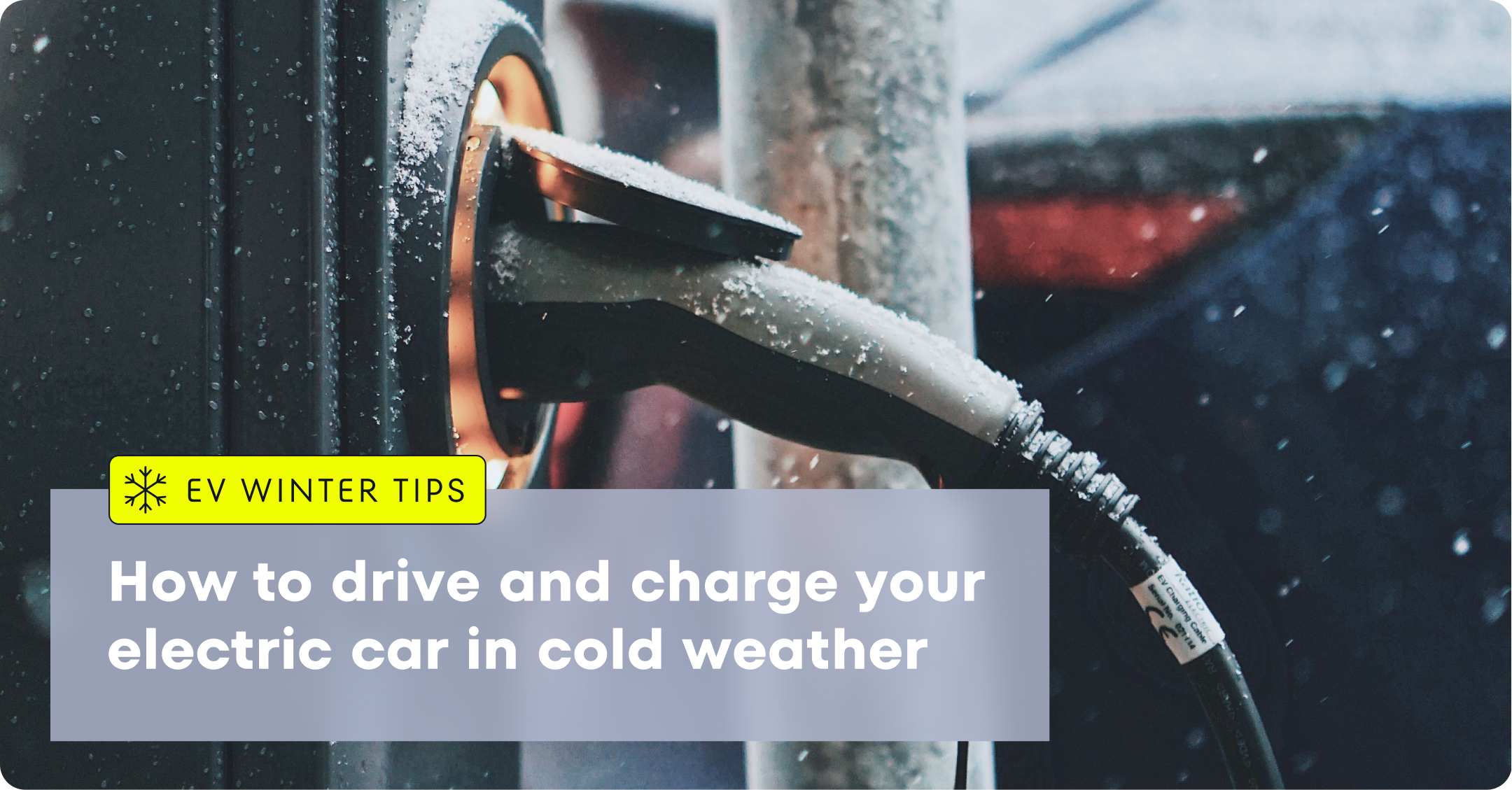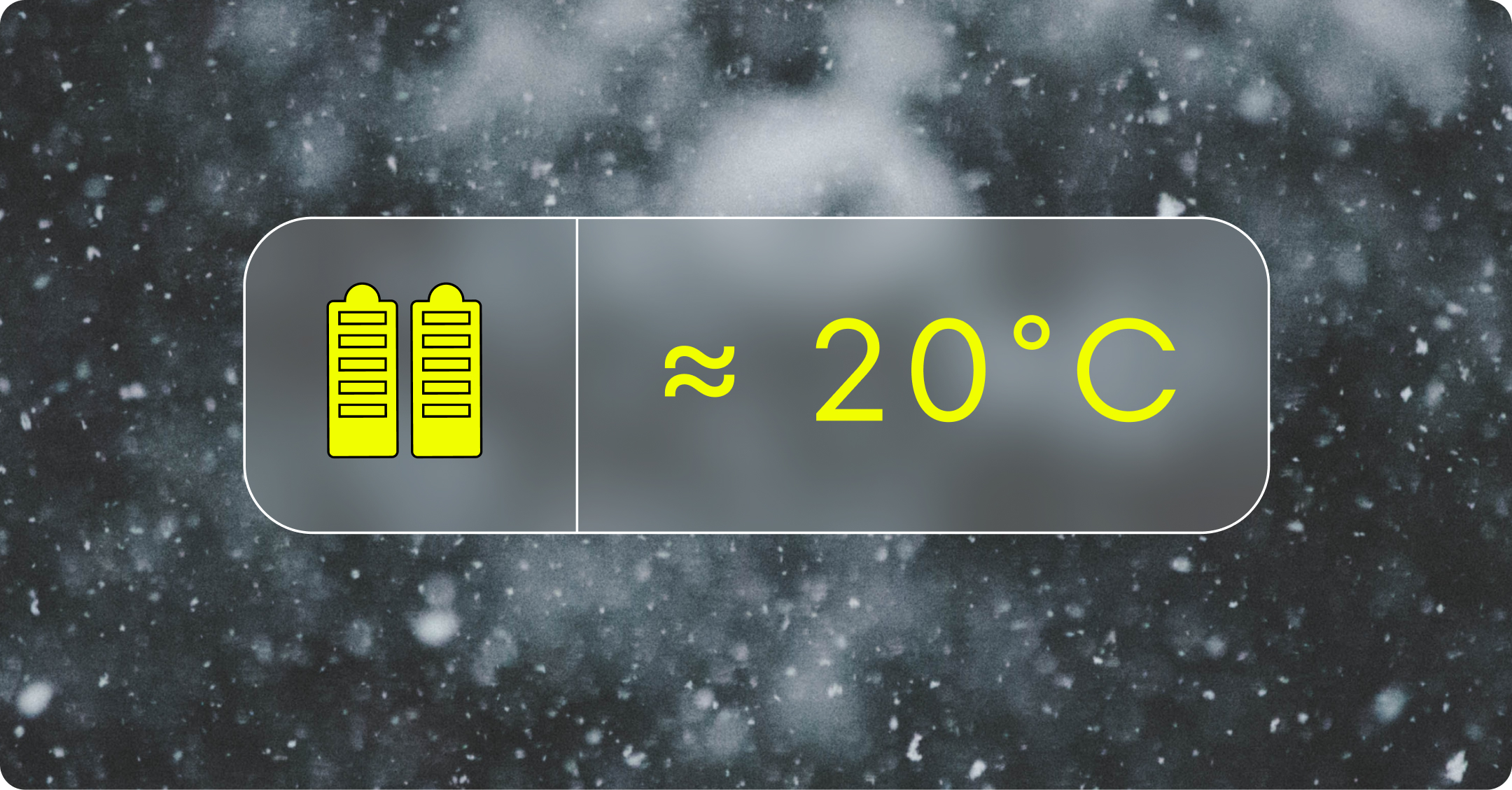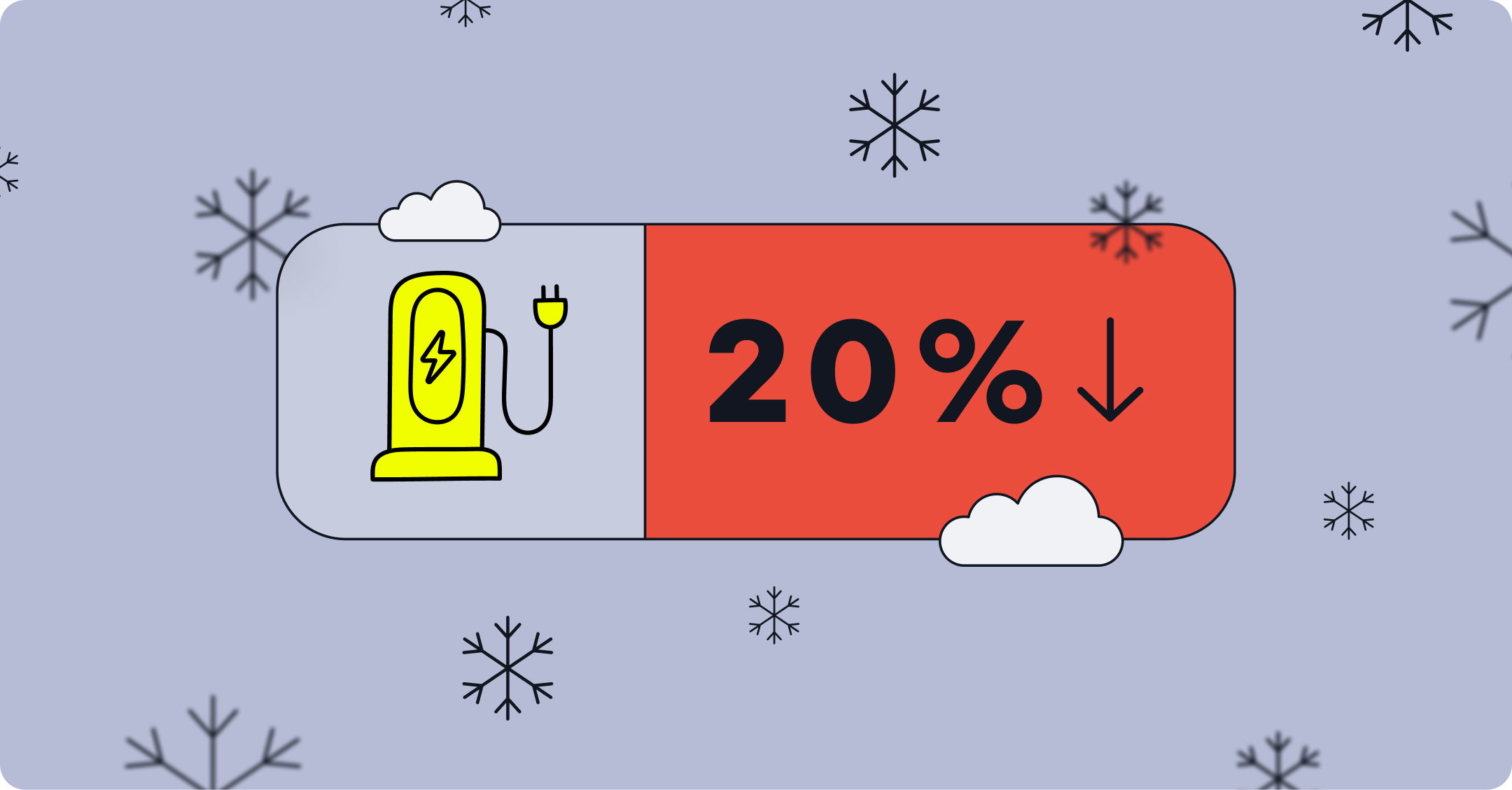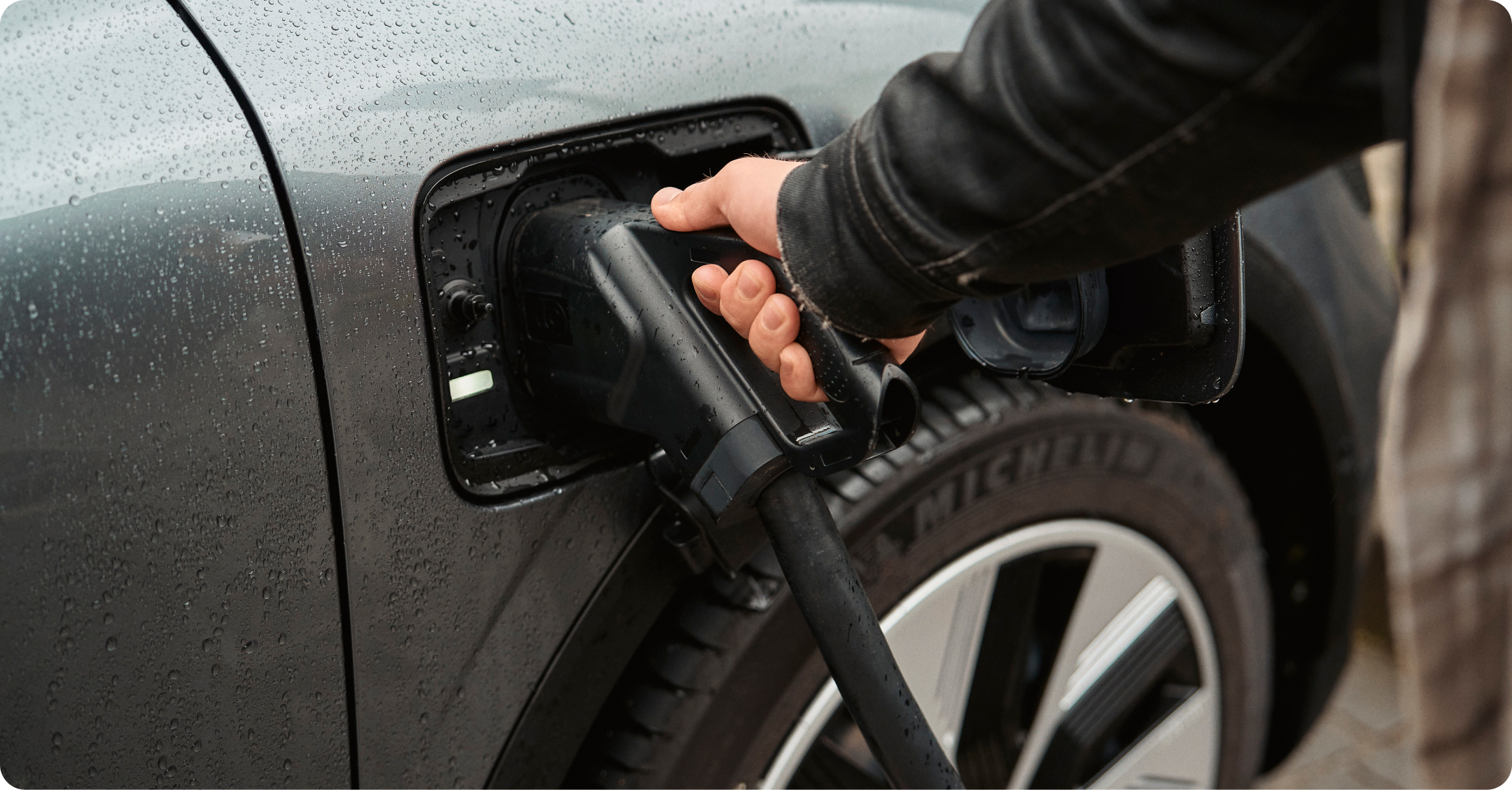
How does cold affect an EV battery?
Cold weather shouldn’t prevent you from driving an EV, but it’s not a friend of your battery either.
The optimum temperature for an EV battery is around 20°C. When the temperature drops below that, the electrochemical reactions within the battery will slow down. This reduces its ability to discharge energy, affecting both the range and performance of the car.
Depending on your vehicle, a freezing temperature can knock up to 30 percent off your optimal range. And the colder it gets, the more drastic the drop.
In addition, a cold battery won’t be able to take in energy as quickly as it would normally do. This makes charging slightly slower.
So is there anything a savvy EV driver driver can do? Yes! By thinking ahead and being prepared you can ensure you get safely from A to B.

Precondition your EV before hitting the road
Precondition the battery → Charge → Heat the cabin → Drive
Warming up your battery is known as preconditioning. If you need an analogy from traditional petrol cars, think of a block heater warming up the engine block for a couple of hours before departure.
When your car is plugged into a charger, you can schedule it to heat up the battery with power coming from the charger, then charge the battery and heat up the cabin.
In most EVs, you’ll find the preconditioning feature in your car’s infotainment system and the accompanying mobile app.
“If you have a home charger, leave the car connected and start the heating in the morning before you leave. You’ll have a warm car and a full battery.” – Frank Janisch, Engineering Manager at Plugsurfing
More than comfort
Having a toasty warm car in the morning is a nice way to start a day. However, preconditioning helps you take care of your car’s battery. When your EV battery is warm, it will work optimally, meaning better performance, longer range, and faster charging.
Preconditioning the battery is also a question of safety. A cold battery can’t take in the energy, and this will also affect regenerative braking. If you’re used to driving with just the accelerator pedal, the disappearance of regenerative brakes can catch you off guard.
“One thing that surprised me is that when it gets too cold, regenerative braking becomes limited or even disabled. If you’re relying on regenerative braking instead of using the brake pedal, it can come as a surprise! Preconditioning the car is a good way to avoid that problem.” – Olivier Payen, Engineering Manager at Plugsurfing

How does cold weather affect charging your EV?
Most drivers make a point to never let their charge drop below a certain level. In the wintertime, you should be extra careful. A cold battery has trouble both taking in and putting out energy. Even though your battery may still have some charge, your car may need to use it to heat up the battery before starting the charging process. That’s why you should never let your charge drop below 20 percent.
In cold conditions charging also takes a bit longer. You’ll be most likely to notice this at high-power chargers: if your battery is cold, your car won’t be able to charge at the maximum speed.
You can avoid this by preconditioning your car before departure. But if you’ve fully charged when you leave, the chances are you’ve had to make a longer stop before charging again, thus letting your car cool down. So budget some extra time when you’re charging a cold battery.
Keep yourself and your car warm
If you can, shelter your car from the elements and park inside, preferably in a heated garage. If this is not possible during your work day, try to find a spot that gets the maximum amount of sunlight. It’s not going to miraculously heat up your car, but it’s better than nothing.
If you parked outside, make sure to brush and scrape off all the snow and ice on your car. It’s a question of both economy and safety. Excess snow will create more wind resistance, meaning your charge won’t take you as far as it would take a car that’s fully thawed. Also, a big layer of snow on your roof or hood can result in a dangerous situation when suddenly shifting and blocking your view.
An electric car doesn’t have an internal combustion engine that creates loads of excess heat. That’s why your car has to use the battery charge to operate the heat pump or resistive heater that warms up the cabin. To make sure you’re putting the heat where it’s needed, use the seat and steering wheel heaters instead of the car’s air conditioning system.
You should also dress for the season: if you’re driving around in shorts and flip-flops, the chances are you’re going to use your cabin heater more than someone comfily wrapped in Canada Goose.
“Warming up the car takes a lot of energy. It can be a shock to see a 50-kilometer range reduction after driving less than 5 kilometers. Getting stuck in a queue puts a big strain on your battery. If the road is completely stopped and the temperature is below zero, consider wearing a warm coat and turning off the car (with hazards on) to conserve energy. It’s better doing that than having to walk later on.” – Matthew Lapsley, Head of Core Services at Plugsurfing

Make sure your tires can take the strain
The winter tire regulations vary from one country to another. Some places have strict rules about using spikes, chains, and mud and snow tires. When driving from one country to another, make sure you follow the local winter tire rules.
You should also invest in quality tires and keep them properly inflated. EVs have big battery elements in their undercarriage, meaning they are often heavier than traditional cars. Make sure you pick tires that can take this extra weight.
When it gets cold, the air in the tire takes up less space, thus lowering the pressure. For every 10°C drop in temperature, the pressure drops by 0.07 to 0.14 bars. That’s why you should check the tire pressure regularly, especially in winter. You’ll find the correct pressure information in your car’s owner’s manual.

Slow down
The faster you drive, the shorter your range. If you want to get as far as possible on a single charge, don’t put the pedal to the metal.
Many EVs also have different driving modes that emphasize performance or range. By switching from a sporty setting to a more sensible economy mode, you can make your charge last longer.
Using regenerative braking should also help you conserve your range, especially when driving in a city. To safely use regenerative braking, remember to precondition your car’s battery.
Note that road conditions also affect your range. If you’re driving uphill, against the wind, or through snow and slush, you’re not going to get as far as you normally would. Keep an eye on the remaining range: it will give you real-time data on how far you can go before another charge.
”What threw off my car’s range prediction was the impact of road conditions on consumption. If there is a lot of fresh snow, slush or just rain, the consumption goes up and the range goes down. I had to learn this the hard way on a trip through the north of Finland. Had we stayed on our initially planned route we would not have reached the next charger. In such situations I find it very reassuring to have many alternative charging options on route.” – Benjamin Rinner, Head of Networks at Plugsurfing

Plan your charging stops with Plugsurfing
To help you get safely to your destination, we’re soon introducing a new feature in the Plugsurfing app. We call it Plan your route and charging stops.
Choose the optimal place to charge on your way. Just enter your remaining charge and destination, and we’ll take care of the rest.
To plan your route and charging stops, you’ll need to add your car model to the app. In addition to being able to use the route planner feature, you’ll also see useful information about your vehicle, including the range, consumption, and supported plug types.
Click on My car in the Account tab in the Plugsurfing app to add your car model today.

